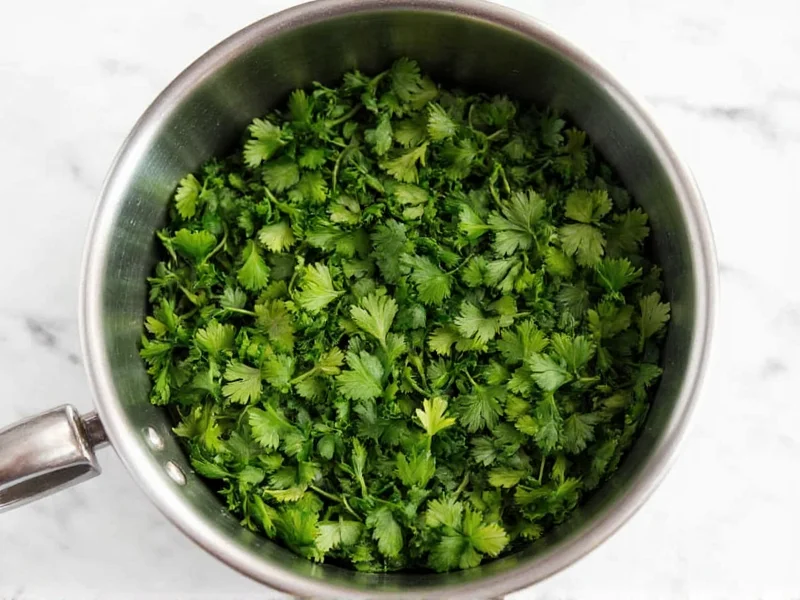1/3 cup fresh parsley equals 1 tablespoon dried parsley. This 3:1 conversion ratio (fresh to dried) accounts for the concentrated flavor and reduced moisture content in dried herbs.
Understanding herb conversions is essential for consistent cooking results. When recipes call for fresh parsley but you only have dried available, knowing the proper measurement substitution prevents flavor imbalances in your dishes. The 3:1 ratio exists because dried herbs contain less moisture and more concentrated essential oils than their fresh counterparts.
The Science Behind Herb Conversion Ratios
Fresh herbs consist of approximately 85-90% water, while dried herbs have most moisture removed through dehydration. This concentration process means dried herbs deliver more intense flavor per volume. The standard culinary guideline maintains that 1 tablespoon of dried herb equals 3 tablespoons (or 1/4 cup) of fresh herb. Therefore, scaling up:
| Fresh Parsley | Dried Parsley Equivalent |
|---|---|
| 1 cup | 1/3 cup |
| 3/4 cup | 1/4 cup |
| 1/2 cup | 2 tablespoons |
| 1/3 cup | 1 tablespoon |
| 1/4 cup | 1½ teaspoons |
| 2 tablespoons | 2 teaspoons |
Practical Application in Recipe Development
When converting 1 3 cup parsley to dried measurements in recipes, consider these factors that affect the final outcome:
- Recipe moisture content: In soups and stews with high liquid content, you might increase dried herb amounts by 25% since liquid dilutes flavor
- Cooking time: Add dried herbs earlier in the cooking process to allow rehydration and flavor release
- Flavor profile differences: Dried parsley has a more earthy, less bright flavor than fresh varieties
- Storage conditions: Older dried herbs lose potency, potentially requiring slightly increased measurements
Common Measurement Mistakes to Avoid
Cooks frequently make these errors when converting fresh to dried parsley measurements:
- Using equal volumes: Treating 1/3 cup fresh parsley the same as 1/3 cup dried creates overpowering, bitter results
- Ignoring recipe timing: Adding dried herbs at the same stage as fresh prevents proper flavor development
- Not adjusting for herb quality: Premium dried herbs may require less quantity than older, stale products
- Overpacking measuring spoons: Lightly fill dried herb measurements rather than packing them down
Optimizing Dried Parsley Usage
For best results when substituting dried for fresh parsley:
Reconstitute dried parsley by mixing it with a small amount of warm water or broth 10-15 minutes before adding to recipes. This simple step restores some moisture content and creates more balanced flavor distribution. When working with the 1/3 cup fresh parsley to dried conversion, remember that dried parsley works particularly well in:
- Long-simmered tomato sauces and stews
- Dry rubs for meats and vegetables
- Homemade spice blends and seasoning mixes
- Bread doughs and savory baked goods
Fresh parsley generally performs better in:
- Garnishes and finishing touches
- Cold dishes like potato or pasta salads
- Quick-cooking recipes with minimal heat exposure
- Vinaigrettes and fresh herb sauces
Storage Tips for Maximum Potency
Proper storage significantly impacts dried parsley potency. Keep your dried herbs in airtight containers away from light, heat, and moisture. Under optimal conditions, dried parsley maintains peak flavor for 6-12 months. Test your dried parsley's freshness by rubbing a small amount between your fingers - if the aroma is weak or musty, replace it. When converting measurements for older dried herbs, you might need to increase quantities by 20-25% to achieve equivalent flavor to fresh.
Recipe Conversion Example
Consider a pasta sauce recipe calling for 1/3 cup fresh chopped parsley. Using the standard conversion ratio:
- 1/3 cup fresh parsley = 1 tablespoon dried parsley
- Add the dried parsley when sautéing onions and garlic to allow flavor development
- Stir in 1 teaspoon of the dried parsley near the end for brighter flavor notes
This approach mimics the dual addition timing often used with fresh parsley (some added during cooking, some as garnish) while accounting for the 1 3 cup parsley to dried measurement conversion.











 浙公网安备
33010002000092号
浙公网安备
33010002000092号 浙B2-20120091-4
浙B2-20120091-4